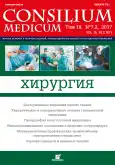Тромбопрофилактика при гемодиализе
- Авторы: Милованов Ю.С.1, Добросмыслов И.А.1, Милованова С.Ю.1
-
Учреждения:
- ФГАОУ ВО «Первый МГМУ им. И.М.Сеченова»
- Выпуск: Том 19, № 7-2 (2017)
- Страницы: 51-54
- Раздел: Статьи
- URL: https://journals.rcsi.science/2075-1753/article/view/94821
- DOI: https://doi.org/10.26442/2075-1753_19.7.2.51-54
- ID: 94821
Цитировать
Полный текст
Аннотация
Полный текст
Открыть статью на сайте журналаОб авторах
Юрий Сергеевич Милованов
ФГАОУ ВО «Первый МГМУ им. И.М.Сеченова»д-р мед. наук, проф. каф. внутренних, профессиональных болезней и пульмонологии 119991, Russian Federation, Moscow, ul. Trubetskaia, d. 8, str. 2
Игорь Александрович Добросмыслов
ФГАОУ ВО «Первый МГМУ им. И.М.Сеченова»врач-нефролог, зав. отд-нием «Искусственная почка» Университетской клинической больницы №3 119991, Russian Federation, Moscow, ul. Trubetskaia, d. 8, str. 2
Светлана Юрьевна Милованова
ФГАОУ ВО «Первый МГМУ им. И.М.Сеченова»
Email: yuriymilovanov@mail.ru
д-р мед. наук, вед. науч. сотр. научно-исследовательского отд. здоровьесберегающих технологий Научно-технологического парка биомедицины 119991, Russian Federation, Moscow, ul. Trubetskaia, d. 8, str. 2
Список литературы
- Бикбов Б.Т., Томилина Н.А. Заместительная терапия больных с хронической почечной недостаточностью в Российской Федерации в 1998-2011 гг. (Отчет по данным Российского регистра заместительной почечной терапии). Нефрология и диализ. 2014; 16 (1): 3-12.
- Готье С.В., Мойсюк Я.Г., Хомяков С.М. Донорство и трансплантация органов в Российской Федерации. VI сообщение регистра Российского трансплантологического общества. Вестн. трансплантологии и искусственных органов. 2014; 16 (2): 3-9
- National Kidney Foundation KDOQI Clinical Practice Guidelines for Vascular Access, Update 2006.
- Николаев А.Ю., Милованов Ю.С. Лечение почечной недостаточности. Руководство для врачей. 2-е изд. М.: МИА, 2011.
- National Kidney Foundation KDOQI Clinical Practice Guidelines for Cardiovascular Disease in Dialysis Patients 2005.
- KDIGO 2012 Clinical Practice Guideline for the Evaluation and Management of Chronic Kidney Disease. Kidney Int 2013; 3 (1).
- European Best Practice Guidelines for Haemodialysis (Part 1). Nephrol Dial Transplant 2002; 17 (Suppl. 7).
- European best practice guidelines on haemodialysis (Part 2). Nephrol Dial Transplant 2007; 22 (Suppl. 2).
- National Kidney Foundation KDOQI Clinical Practice Guidelines for Hemodialysis Adequacy, Update 2006.
- Davenport A. Optimization of heparin anticoagulation for hemodialysis. Hemodial Int 2011; 15 (Suppl. 1): 43-8.
- Fischer K.G. Essentials of anticoagulation in hemodialysis. Hemodial Int 2007; 11: 178-89.
- KDIGO Clinical Practice Guideline for Anemia in Chronic Kidney Disease Kidney Int Supplements 2012; 2 (4).
- Daugirdas J.T. Simplified equations for monitoring Kt/V, PCRn, eKt/V, and ePCRn. Adv Ren Replace Ther 1995; 2 (4): 295-304.
Дополнительные файлы






